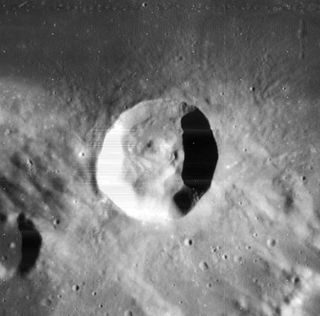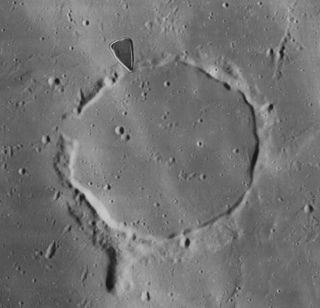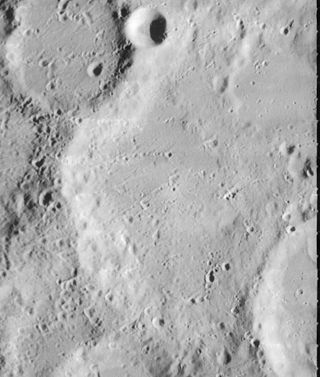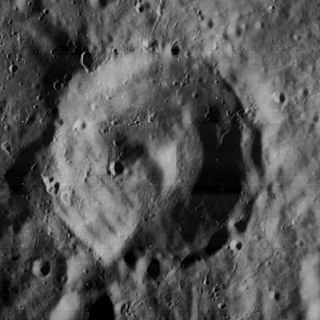
Menelaus is a young lunar impact crater located on the southern shore of Mare Serenitatis near the eastern end of the Montes Hæmus mountain range. Its diameter is 27 km. To the southwest is the small crater Auwers, and to the west-southwest is the even smaller Daubrée. To the northeast is a faint rille system named the Rimae Menelaus.

Bobillier is a tiny, cup-shaped lunar impact crater in the southwest part of Mare Serenitatis. It was named after French geometer Étienne Bobillier in 1976. It lies to the north-northwest of the crater Bessel. To the south and west is a wrinkle ridge designated Dorsum Buckland. Bobillier was previously identified as Bessel E.

Deseilligny is a small lunar impact crater in the southern part of the Mare Serenitatis. It was named after French selenographer Jules Deseilligny. It is located to the east-southeast of the crater Bessel. Deseilligny is a bowl-shaped crater with a low rim. It is otherwise undistinguished.

Finsch is a relatively small lunar impact crater in the mid-part of Mare Serenitatis that has been almost completely covered by the mare, forming a ghost crater in the lava plain. It was named after German zoologist Otto Finsch. It is located to the south-southeast of the crater Sarabhai and northeast of Bessel.

Kies is the remnant of a lunar impact crater that has been flooded by basaltic lava, leaving only a remnant of the outer rim. It was named after German mathematician and astronomer Johann Kies. It is located in the Mare Nubium almost due south of the crater Bullialdus. Northwest of Kies is König. To the south-southwest lies a lunar dome structure designated Kies Pi (π). It has a small crater at the top and is most likely volcanic in origin.

Longomontanus is an ancient lunar impact crater located in the rugged southern highlands to the southwest of the bright ray crater Tycho. Longomontanus is of the variety of large lunar formations called a "walled plain", although it is actually more of a circular depression in the surface.

Pictet is a lunar impact crater located just to the east of the larger and more prominent impact crater Tycho. The high-albedo rays and ejecta from Tycho lie across Pictet and spread far to the east and in other directions. Pictet is older than Tycho and is somewhat worn by past impacts. The slightly smaller crater Pictet A intrudes slightly into the southwest rim. The larger crater Pictet E is nearly joined to the north rim. To the east is Saussure, and to the northeast is the larger, worn formation Orontius.

Polybius is a lunar impact crater in the southeast part of the Moon, and is named after ancient Greek historian Polybius. It is located to the south-southeast of the larger crater Catharina, in the area framed by the Rupes Altai scarp. Some distance to the northeast is the Mare Nectaris, with the flooded craters Beaumont and Fracastorius.

Orontius is a lunar impact crater that lies in the heavily cratered southern highlands of the Moon's near side. It was named after 16th century French mathematician Oronce Fine. It is located to the northwest of the prominent ray crater Tycho, and south and east of the large walled plain Deslandres. The eastern part of the crater is overlain by the smaller crater Huggins, which is overlain in turn on its eastern rim by the still smaller Nasireddin, the trio forming a crater chain of diminishing dimensions. Joined to the southern rim is the crater Saussure. To the southwest, just east of Tycho, is Pictet.

Kepler is a lunar impact crater that lies between the Oceanus Procellarum to the west and Mare Insularum in the east. To the southeast is the crater Encke. Kepler is named for the 17th century German astronomer and mathematician Johannes Kepler.

La Caille is a lunar impact crater located in the rugged south-central highlands of the Moon. It was named after the French astronomer Nicolas-Louis de Lacaille. It is located to the northeast of the crater Purbach. Nearly attached to the southeast rim are the remains of Blanchinus, and the two are separated by a rugged stretch of terrain. To the northeast is Delaunay, a formation split in half by a ridge.

Atwood is a small earth moon impact crater that is located on the Mare Fecunditatis, to the northwest of the prominent crater Langrenus. It forms a triple-crater formation with Naonobu attached to the north rim and Bilharz near the west rim.

Auwers is a small lunar impact crater located in the Montes Haemus mountain range at the south edge of Mare Serenitatis. It is named after German astronomer Arthur Auwers. It lies southeast of the crater Menelaus. The irregular rim of Auwers has a gap at the north-northwest edge, which allowed lava flows to reach the crater floor and flood the interior.

Brown is a lunar impact crater that is located in the southeast part of the Moon, to the southwest of the prominent ray crater Tycho. Northwest of Brown is the crater Wilhelm, and to the west is Montanari. This crater was named after Ernest William Brown, and is distinct from crater D. Brown, a satellite crater of the Apollo crater.

Ball is a lunar impact crater that is located in the rugged southern highlands of the Moon. It was named after British astronomer William Ball. The formation is circular and symmetrical, and has received little significant wear. The interior is rough-surfaced, curving downward toward the relatively wide central peak at the midpoint.

Daubrée is a lunar impact crater that is located to the southwest of the Mare Serenitatis, just to the west-southwest of the crater Menelaus in the Montes Haemus range. The small lunar mare Lacus Hiemalis lies along the southwest rim of Daubrée. The crater was named after French geologist Gabriel A. Daubrée. It was previously designated Menelaus S.

Cichus is a lunar impact crater that lies in the southwestern part of the Moon, at the eastern edge of Palus Epidemiarum. Just to the northeast and nearly contacting the rim is the lava-flooded crater remnant Weiss. The crater is named after Italian astronomer Cecco d'Ascoli.

Weiss is a lunar impact crater along the southern edge of the Mare Nubium. It was named after Austrian astronomer Edmund Weiss. Nearly attached to the southwest rim is the crater Cichus, and Pitatus lies just over one crater diameter to the east-northeast. To the east-southeast lies the eroded Wurzelbauer.

Goodacre is a lunar impact crater. It is located in the rugged southern highlands on the Moon's near side, and is attached to the north-northeastern part of the exterior of Gemma Frisius, a heavily worn and much larger formation. About two crater diameters to the north of Goodacre lies Pontanus.

Mandelʹshtam is the remains of a large crater on the Moon's far side named after Leonid Mandelstam. Nearly attached to the northeast outer rim is the crater Papaleksi. To the south lies the crater Vening Meinesz.

























